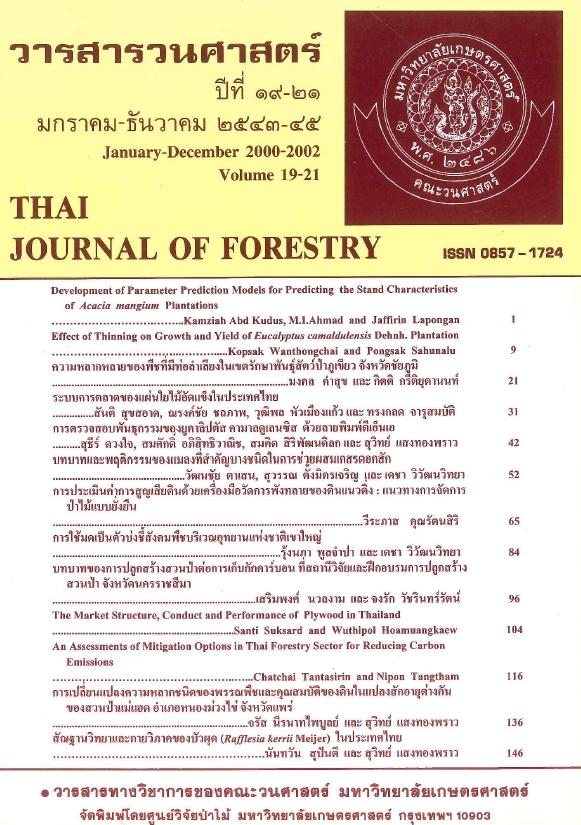การประเมินค่าการสูญเสียดินด้วยเครื่องมือวัดการพังทลายของดินแนวดิ่ง : แนวทางการจัดการป่าไม้แบบยั่งยืน
Main Article Content
บทคัดย่อ
การประเมินค่าการสูญเสียดินด้วยเครื่องมือวัดการพังทลายของดินแนวดิ่ง (erosion bridge) เพื่อหาแนวทางการจัดการป่าไม้แบบยั่งยืนนี้ได้ทำการเก็บข้อมูลบริเวณลุ่มน้ำห้วยน้ำกัด สถานีวิจัยลุ่มน้ำขุนคอง จังหวัดเชียงใหม่ โดยใช้การสูญเสียคนในแต่ละประเภทการใช้ประโยชน์ที่ดิน ได้แก่ พื้นที่ไร่เลื่อนลอย ป่าสนธรรมชาติ สวนป่าสนสามใบ ไหล่ทาง และถนนป่าไม้ ผลการศึกษาชี้ให้เห็นว่าไร่เลื่อนลอยเป็นรูปแบบการใช้ประโยชน์ที่ดินที่ก่อให้เกิดการเปลี่ยนแปลงผิวดินแนวดิ่งรายเดือนมากที่สุด 34,018 มิลลิเมตร รองลงมาคือพื้นที่ถนนป่าไม้ สวนป่าสนสามใบ ป่าสนธรรมชาติ และไหล่ทาง โดยมีค่า 21.134, 11.371, 4.741 และ 4.326 มิลลิเมตร ตามลำดับ สัดส่วนการเคลื่อนย้ายตะกอนพื้นที่ลุ่มน้ำห้วยน้ำกัดมีค่า 0.263 ปริมาณตะกอนที่สูญเสียออกจากพื้นที่มีค่า 9.441 ตัน/ไร่/เดือน และปริมาณตะกอนวัดได้บริเวณเขื่อนวัดน้ำมีค่า 2481 ตัน/ไร่/เดือน ปริมาณการสูญเสียคนรายปี พบว่าไร่เลื่อนลอยเป็นรูปแบบการใช้ประโยชน์ที่ดินที่มีการสูญเสียดินมากที่สุด 58.674 ตัน/ไร่/ปี รองลงมาคือพื้นที่ถนนป่าไม้ สวนป่าสนสามใบ และป่าสนธรรมชาติ โดยมีการสูญเสียดิน 29.216, 15.992 และ 9.406 ตัน/ไร่/ปี ตามลำดับ การปลูกป่าเสริมในพื้นที่ว่างเปล่าและพื้นที่เสื่อมโทรมสามารถลดการสูญเสียดินลงได้และในไม่ช้าสามารถฟื้นตัวเป็นป่าธรรมชาติได้ ทั้งนี้เนื่องจากพื้นที่ป่าธรรมชาติมีการสูญเสียดินออกจากพื้นที่น้อยที่สุด การใช้ระบบวนเกษตรในการอนุรักษ์ดินและน้ำ เป็นอีกมาตรการหนึ่งที่ช่วยส่งเสริมให้มีการปลูกป่าร่วมกับพืชเกษตรควบคู่กันไป
Downloads
Article Details

อนุญาตภายใต้เงื่อนไข Creative Commons Attribution-NonCommercial-NoDerivatives 4.0 International License.
ข้าพเจ้าและผู้เขียนร่วม (ถ้ามี) ขอรับรองว่า ต้นฉบับที่เสนอมานี้ยังไม่เคยได้รับการตีพิมพ์และไม่ได้อยู่ในระหว่างกระบวนการพิจารณาตีพิมพ์ลงในวารสารหรือสิ่งตีพิมพ์อื่นใด ข้าพเจ้าและผู้เขียนร่วม (ถ้ามี) ยอมรับหลักเกณฑ์และเงื่อนไขการพิจารณาต้นฉบับ ทั้งยินยอมให้กองบรรณาธิการมีสิทธิ์พิจารณาและตรวจแก้ต้นฉบับได้ตามที่เห็นสมควร พร้อมนี้ขอมอบลิขสิทธิ์ผลงานที่ได้รับการตีพิมพ์ให้แก่วารสารวนศาสตร์ คณะวนศาสตร์ มหาวิทยาลัยเกษตรศาสตร์ กรณีมีการฟ้องร้องเรื่องการละเมิดลิขสิทธิ์เกี่ยวกับภาพ กราฟ ข้อความส่วนใดส่วนหนึ่ง หรือ ข้อคิดเห็นที่ปรากฏในผลงาน ให้เป็นความรับผิดชอบของข้าพเจ้าและผู้เขียนร่วม (ถ้ามี) แต่เพียงฝ่ายเดียว และหากข้าพเจ้าและผู้เขียนร่วม (ถ้ามี) ประสงค์ถอนบทความในระหว่างกระบวนการพิจารณาของทางวารสาร ข้าพเจ้าและผู้เขียนร่วม (ถ้ามี) ยินดีรับผิดชอบค่าใช้จ่ายทั้งหมดที่เกิดขึ้นในกระบวนการพิจารณาบทความนั้น”


